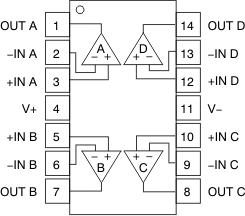-
TLVx316 10-MHz, Rail-to-Rail Input/Output, Low-Voltage, 1.8-V CMOS Operational Amplifiers
- 1 Features
- 2 Applications
- 3 Description
- 4 Revision History
- 5 Device Comparison Table
- 6 Pin Configuration and Functions
- 7 Specifications
- 8 Detailed Description
- 9 Application and Implementation
- 10Power Supply Recommendations
- 11Layout
- 12Device and Documentation Support
- 13Mechanical, Packaging, and Orderable Information
- IMPORTANT NOTICE
Package Options
Mechanical Data (Package|Pins)
Thermal pad, mechanical data (Package|Pins)
Orderable Information
TLVx316 10-MHz, Rail-to-Rail Input/Output, Low-Voltage, 1.8-V CMOS Operational Amplifiers
1 Features
- Unity-Gain Bandwidth: 10 MHz
- Low IQ: 400 µA/ch
- Excellent Power-to-Bandwidth Ratio
- Stable IQ Over Temperature and Supply Range
- Wide Supply Range: 1.8 V to 5.5 V
- Low Noise: 12 nV/√Hz at 1 kHz
- Low Input Bias Current: ±10 pA
- Offset Voltage: ±0.75 mV
- Unity-Gain Stable
- Internal RFI/EMI Filter
- Extended Temperature Range: –40°C to +125°C
2 Applications
- Battery-Powered Instruments:
- Consumer, Industrial, Medical
- Notebooks, Portable Media Players
- Sensor Signal Conditioning
- Barcode Scanners
- Active Filters
- Audio
3 Description
The TLV316 (single), TLV2316 (dual), and TLV4316 (quad) devices comprise a family of general-purpose, low-power operational amplifiers. Features such as rail-to-rail input and output swings, low quiescent current (400 μA/ch typical) combined with a wide bandwidth of 10 MHz, and very-low noise (12 nV/√Hz at 1 kHz) make this family attractive for a variety of applications that require a good balance between cost and performance. The low input bias current supports operational amplifiers that are used in applications with megaohm source impedances.
The robust design of the TLVx316 provides ease-of-use to the circuit designer—a unity-gain stable, integrated RFI/EMI rejection filter, no phase reversal in overdrive condition, and high electrostatic discharge (ESD) protection (4-kV HBM).
These devices are optimized for low-voltage operation as low as 1.8 V (±0.9 V) and up to 5.5 V (±2.75 V). This latest addition of low-voltage CMOS operational amplifiers to the portfolio, in conjunction with the TLVx313 and TLVx314 series, offer a family of bandwidth, noise, and power options to meet the needs of a wide variety of applications.
Device Information(1)
| PART NUMBER | PACKAGE | BODY SIZE (NOM) |
|---|---|---|
| TLV316 | SC70 (5) | 1.25 mm × 2.00 mm |
| SOT-23 (5) | 1.60 mm × 2.90 mm | |
| TLV2316 | VSSOP (8) | 3.00 mm × 3.00 mm |
| SOIC (8) | 3.91 mm × 4.90 mm | |
| TLV4316 | TSSOP (14) | 4.40 mm × 5.00 mm |
| SOIC (14) | 8.65 mm × 3.91 mm |
- For all available packages, see the orderable addendum at the end of the data sheet.
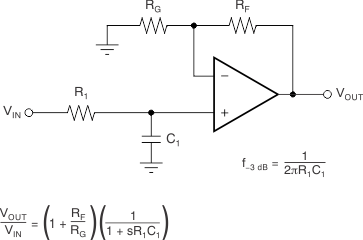 Single-Pole, Low-Pass Filter
Single-Pole, Low-Pass Filter
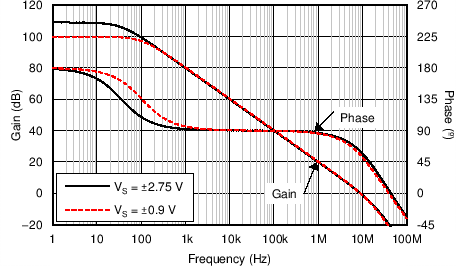 Low Supply Current (400 µA/Ch) for 10-MHz Bandwidth
Low Supply Current (400 µA/Ch) for 10-MHz Bandwidth
6 Pin Configuration and Functions
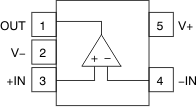
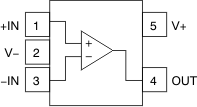
Pin Functions: TLV316
| PIN | I/O | DESCRIPTION | ||
|---|---|---|---|---|
| NAME | DBV (SOT-23) | DCK (SC70) | ||
| –IN | 4 | 3 | I | Inverting input |
| +IN | 3 | 1 | I | Noninverting input |
| OUT | 1 | 4 | O | Output |
| V– | 2 | 2 | — | Negative (lowest) supply or ground (for single-supply operation) |
| V+ | 5 | 5 | — | Positive (highest) supply |
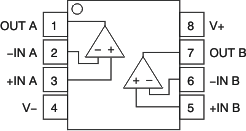
Pin Functions: TLV2316
| PIN | I/O | DESCRIPTION | |
|---|---|---|---|
| NO. | NAME | ||
| 2 | –IN A | I | Inverting input, channel A |
| 3 | +IN A | I | Noninverting input, channel A |
| 6 | –IN B | I | Inverting input, channel B |
| 5 | +IN B | I | Noninverting input, channel B |
| 1 | OUT A | O | Output, channel A |
| 7 | OUT B | O | Output, channel B |
| 4 | V– | — | Negative (lowest) supply or ground (for single-supply operation) |
| 8 | V+ | — | Positive (highest) supply |
Pin Functions: TLV4316
| PIN | I/O | DESCRIPTION | |
|---|---|---|---|
| NO. | NAME | ||
| 2 | –IN A | I | Inverting input, channel A |
| 3 | +IN A | I | Noninverting input, channel A |
| 6 | –IN B | I | Inverting input, channel B |
| 5 | +IN B | I | Noninverting input, channel B |
| 9 | –IN C | I | Inverting input, channel C |
| 10 | +IN C | I | Noninverting input, channel C |
| 13 | –IN D | I | Inverting input, channel D |
| 12 | +IN D | I | Noninverting input, channel D |
| 1 | OUT A | O | Output, channel A |
| 7 | OUT B | O | Output, channel B |
| 8 | OUT C | O | Output, channel C |
| 14 | OUT D | O | Output, channel D |
| 11 | V– | — | Negative (lowest) supply or ground (for single-supply operation) |
| 4 | V+ | — | Positive (highest) supply |
7 Specifications
7.1 Absolute Maximum Ratings
over operating free-air temperature (unless otherwise noted)(1)| MIN | MAX | UNIT | |||
|---|---|---|---|---|---|
| Supply voltage | 7 | V | |||
| Signal input pins | Voltage(2) | Common-mode | (V–) – 0.5 | (V+) + 0.5 | V |
| Differential | (V+) – (V–) + 0.2 | ||||
| Current(2) | –10 | 10 | mA | ||
| Output short-circuit(3) | Continuous | mA | |||
| Temperature | Specified, TA | –40 | 125 | °C | |
| Junction, TJ | 150 | ||||
| Storage, Tstg | –65 | 150 | |||
7.2 ESD Ratings
over operating free-air temperature range (unless otherwise noted)| VALUE | UNIT | |||
|---|---|---|---|---|
| V(ESD) | Electrostatic discharge | Human body model (HBM), per ANSI/ESDA/JEDEC JS-001(1) | ±4000 | V |
| Charged device model (CDM), per JEDEC specification JESD22-C101(2) | ±1500 | |||
7.3 Recommended Operating Conditions
over operating free-air temperature range (unless otherwise noted)| MIN | NOM | MAX | UNIT | |||
|---|---|---|---|---|---|---|
| VS | Supply voltage | 1.8 | 5.5 | V | ||
| Specified temperature range | –40 | 125 | °C | |||
7.4 Thermal Information: TLV316
| THERMAL METRIC(1) | TLV316 | UNIT | ||
|---|---|---|---|---|
| DBV (SOT-23) | DCK (SC70) | |||
| 5 PINS | 5 PINS | |||
| RθJA | Junction-to-ambient thermal resistance | 221.7 | 263.3 | °C/W |
| RθJC(top) | Junction-to-case(top) thermal resistance | 144.7 | 75.5 | °C/W |
| RθJB | Junction-to-board thermal resistance | 49.7 | 51.0 | °C/W |
| ψJT | Junction-to-top characterization parameter | 26.1 | 1.0 | °C/W |
| ψJB | Junction-to-board characterization parameter | 49.0 | 50.3 | °C/W |
| RθJC(bot) | Junction-to-case(bottom) thermal resistance | N/A | N/A | °C/W |
7.5 Thermal Information: TLV2316
| THERMAL METRIC(1) | TLV2316 | UNIT | ||
|---|---|---|---|---|
| D (SOIC) | DGK (VSSOP) | |||
| 8 PINS | 8 PINS | |||
| RθJA | Junction-to-ambient thermal resistance | 127.2 | 186.6 | °C/W |
| RθJC(top) | Junction-to-case(top) thermal resistance | 71.6 | 78.8 | °C/W |
| RθJB | Junction-to-board thermal resistance | 68.2 | 107.9 | °C/W |
| ψJT | Junction-to-top characterization parameter | 22.0 | 15.5 | °C/W |
| ψJB | Junction-to-board characterization parameter | 67.6 | 106.3 | °C/W |
| RθJC(bot) | Junction-to-case(bottom) thermal resistance | N/A | N/A | °C/W |
7.6 Thermal Information: TLV4316
| THERMAL METRIC(1) | TLV4316 | UNIT | ||
|---|---|---|---|---|
| PW (TSSOP) | D (SOIC) | |||
| 14 PINS | 14 PINS | |||
| RθJA | Junction-to-ambient thermal resistance | 117.2 | 87.0 | °C/W |
| RθJC(top) | Junction-to-case(top) thermal resistance | 46.2 | 44.4 | °C/W |
| RθJB | Junction-to-board thermal resistance | 58.9 | 41.7 | °C/W |
| ψJT | Junction-to-top characterization parameter | 4.9 | 11.6 | °C/W |
| ψJB | Junction-to-board characterization parameter | 58.3 | 41.4 | °C/W |
| RθJC(bot) | Junction-to-case(bottom) thermal resistance | N/A | N/A | °C/W |
7.7 Electrical Characteristics
at TA = 25°C, RL = 10 kΩ connected to VS / 2, VCM = VS / 2, and VOUT = VS / 2 (unless otherwise noted); VS (total supply voltage) = (V+) – (V–) = 1.8 V to 5.5 V| PARAMETER | TEST CONDITIONS | MIN | TYP | MAX | UNIT | ||
|---|---|---|---|---|---|---|---|
| OFFSET VOLTAGE | |||||||
| VOS | Input offset voltage | VS = 5 V | ±0.75 | ±3 | mV | ||
| VS = 5 V, TA = –40°C to +125°C | ±4.5 | ||||||
| dVOS/dT | Drift | VS = 5 V, TA = –40°C to +125°C | ±2 | µV/°C | |||
| PSRR | Power-supply rejection ratio | VS = 1.8 V – 5.5 V, VCM = (V–) | ±30 | ±175 | µV/V | ||
| Channel separation, dc | At dc | 100 | dB | ||||
| INPUT VOLTAGE RANGE | |||||||
| VCM | Common-mode voltage range | VS = 5.5 V | (V–) – 0.2 | (V+) + 0.2 | V | ||
| CMRR | Common-mode rejection ratio | VS = 5.5 V, (V–) – 0.2 V < VCM < (V+) – 1.4 V, TA = –40°C to +125°C |
72 | 90 | dB | ||
| VS = 5.5 V, VCM = –0.2 V to 5.7 V, TA = –40°C to +125°C |
75 | ||||||
| INPUT BIAS CURRENT | |||||||
| IB | Input bias current | ±10 | pA | ||||
| IOS | Input offset current | ±10 | pA | ||||
| NOISE | |||||||
| En | Input voltage noise (peak-to-peak) | VS = 5 V, f = 0.1 Hz to 10 Hz | 5 | µVPP | |||
| en | Input voltage noise density | VS = 5 V, f = 1 kHz | 12 | nV/√Hz | |||
| in | Input current noise density | f = 1 kHz | 1.3 | fA/√Hz | |||
| INPUT IMPEDANCE | |||||||
| ZID | Differential | 2 || 2 | 1016Ω || pF | ||||
| ZIC | Common-mode | 2 || 4 | 1011Ω || pF | ||||
| OPEN-LOOP GAIN | |||||||
| AOL | Open-loop voltage gain | VS = 5.5 V, (V–) + 0.05 V < VO < (V+) – 0.05 V, RL = 10 kΩ |
100 | 104 | dB | ||
| VS = 5.5 V, (V–) + 0.15 V < VO < (V+) – 0.15 V, RL = 2 kΩ |
104 | ||||||
| FREQUENCY RESPONSE | |||||||
| GBP | Gain bandwidth product | VS = 5 V, G = +1 | 10 | MHz | |||
| φm | Phase margin | VS = 5 V, G = +1 | 60 | Degrees | |||
| SR | Slew rate | VS = 5 V, G = +1 | 6 | V/μs | |||
| tS | Settling time | To 0.1%, VS = 5 V, 2-V step , G = +1, CL = 100 pF | 1 | μs | |||
| tOR | Overload recovery time | VS = 5 V, VIN × gain = VS | 0.8 | μs | |||
| THD + N | Total harmonic distortion + noise(1) | VS = 5 V, VO = 0.5 VRMS, G = +1, f = 1 kHz | 0.008% | ||||
| OUTPUT | |||||||
| VO | Voltage output swing from supply rails | VS = 1.8 V to 5.5 V, RL = 10 kΩ, | 35 | mV | |||
| VS = 1.8 to 5.5 V, RL = 2 kΩ, | 125 | ||||||
| ISC | Short-circuit current | VS = 5 V | ±50 | mA | |||
| ZO | Open-loop output impedance | VS = 5 V, f = 10 MHz | 250 | Ω | |||
| POWER SUPPLY | |||||||
| VS | Specified voltage range | 1.8 | 5.5 | V | |||
| IQ | Quiescent current per amplifier | VS = 5 V, IO = 0 mA, TA = –40°C to 125°C | 400 | 575 | µA | ||
| TEMPERATURE | |||||||
| TA | Specified | –40 | 125 | °C | |||
| Tstg | Storage | –65 | 150 | °C | |||
7.8 Typical Characteristics
Table 1. Table of Graphs
| TITLE | FIGURE |
|---|---|
| Offset Voltage Production Distribution | Figure 1 |
| Offset Voltage vs Common-Mode Voltage | Figure 2 |
| Open- Loop Gain and Phase vs Frequency | Figure 3 |
| Input Bias and Offset Current vs Temperature | Figure 4 |
| Input Voltage Noise Spectral Density vs Frequency | Figure 5 |
| Quiescent Current vs Supply Voltage | Figure 6 |
| Small-Signal Overshoot vs Load Capacitance | Figure 7 |
| No Phase Reversal | Figure 8 |
| Small-Signal Step Response | Figure 9 |
| Large-Signal Step Response | Figure 10 |
| Short-Circuit Current vs Temperature | Figure 11 |
| Electromagnetic Interference Rejection Ratio Referred to Noninverting Input vs Frequency | Figure 12 |
| Channel Separation vs Frequency | Figure 13 |
7.9 Typical Characteristics
at TA = 25°C, VS = 5.5 V, RL = 10 kΩ connected to VS / 2, VCM = VS / 2, and VOUT = VS / 2 (unless otherwise noted)
| Distribution taken from 12551 amplifiers |

| VCM < (V+) – 1.4 V | ||


| V+ = 2.75 V, V– = –2.75 V, G = –1 V/V | ||

| V+ = 2.75 V, V– = –2.75 V, G = 1 V/V | ||


| V+ = 2.75 V, V– = –2.75 V | ||

| V+ = 2.75 V, V– = –2.75 V, 9 typical units shown | ||



| V+ = 2.75 V, V– = –2.75 V | ||

| V+ = 2.75 V, V– = –2.75 V, CL = 100 pF, G = 1 V/V | ||

| PRF = –10 dBm | ||
Referred to Noninverting Input vs Frequency
